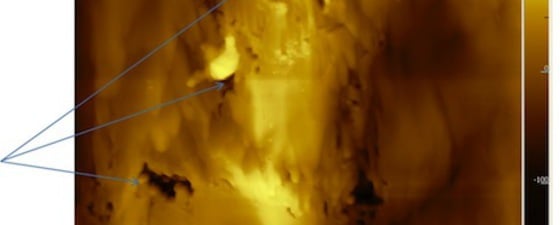Something that we are all familiar with, a human hair, is about 50,000 nanometers (nm) in diameter. Over 1,000 times smaller than the human hair, nanoscale materials occur naturally in the environment. Now, scientists and engineers are arranging collections of tens to thousands of atoms to create nanoparticles that can range from 1 to 100 nm in diameter. The important point here is that these nanoparticles can be built to specific sizes and for specific purposes as well as be assembled to perform specific functions.
Simply put, nanotechnology is the engineering of functional systems at the molecular scale.
Big Differences
One of the exciting and challenging aspects of nanoscale particles is that the behavior can be very different from classical physics, following the much more different rules of quantum mechanics. For example, you cannot walk up to a wall and be teleported to the other side, but, at the nanoscale an electron can. Insulators (substances that cannot conduct an electric charge) can become semiconductors when reduced to the nanoscale. Thermal conductivity and other physical properties can change drastically at the nanoscale.
With particle attributes changing at the nanoscale, scientists are experimenting to learn more about their properties and ways to take advantage of them in various applications. We already use many products that employ nanotechnology such as nanoparticles of zinc oxide or titanium oxide in our sunscreens or as a coating on clothing for better UV protection, in scratch-resistant coatings on our cars and eyeglass lenses, and in making tennis rackets lighter and stronger. The oil and gas industry is also embracing this new and exciting technology.
“Nanotechnology is helping in two key aspects of upstream oil and gas production,” says Dr. Farzam Javadpour, a key researcher in nanotechnology at the Bureau of Economic Geology in Austin, Texas. “One aspect that has become very important for the production of oil and gas from very tight formations such as shale is that this technology gives us a new look and understanding of the reservoir itself and how fluids flow through very small pore space. The second aspect deals with new ways to monitor and enhance the reservoir performance.”
Shale Gas Reservoirs
Hardly a day goes by without news of a shale gas or shale oil play discovery. New drilling and fraccing technology has helped unlock these resources, but what we lack is an understanding of where all these resources are coming from. The mudrocks are composed of very fine grain particles with very small pores, so the traditional Darcy permeability equation cannot explain or describe fluid flow from such small pores. For the first time, technology is now imaging these tiny pores and enabling researchers to unlock some of their secrets.
“The physics of gas flow in tiny pores is different from large pores,” says Dr. Javadpour. “The interaction of gas molecules and the pore inner wall become important, hence molecular interactions should be considered. AFM can measure these force interactions. We are using the measured interactive forces to understand how flow occurs in these very small pores and develop new flow models that will yield better reserve estimation and ultimate recovery.”
Reservoir Performance
Along with all the new shale plays, oil companies are trying to squeeze every drop out of the conventional reservoir that they can. The latest secondary and tertiary recovery methods, drilling muds, and ways of connecting pore space over great distances are yielding good results. Nanotechnology is playing a key role and will be ever-present in the future oil or gas field.
“Nanoparticles have a very large surface area relative to their volume,” says Dr. Javadpour. “The interaction of nanoparticles and mineral grains or fluid interfaces in the reservoir is a new field of research. We can inject a certain volume of nanoparticles with specific characteristics into a well and by analyzing the nanoparticle concentration from an observation well, we learn about the geology and reservoir characteristics. In this case, the nanoparticles act as tracers. We can also make nanoparticles smart and perhaps bring specific information about pressure or even a fluid sample. Another example is that ferromagnetic nanoparticles can be injected into the well bore prior to petrophysical well logging. The injected particles enhance well-log readings and yield better measurements about the reservoir properties. Because of their large surface area to volume ratio, new nanoparticle-surfaced proppants are being developed that could enhance the effectiveness of hydraulic fracturing treatments.”
Dr. Javadpour is the principal investigator on a project examining particle transport in porous media, one of many projects supported by 10 major international oil companies through the Advanced Energy Consortium (AEC). The AEC was the brainchild of Dr. Scott Tinker, Texas State Geologist and Director of the Bureau of Economic Geology at the University of Texas at Austin (see GeoProfile, pages 48-50), and opened in January 2008 with Dr. Tinker serving as Director.
“The AEC funds research projects of particular value to the industry at universities, labs, and companies around the world,” says Dr. Tinker. “The primary goal is to develop intelligent subsurface micro and nanosensors that can be injected into oil and gas reservoirs to help characterize these reservoirs and improve recovery.”
(Editor’s note: This article is a brief introduction into nanotechnology. A more comprehensive article will appear in our issue on new technologies next year.)





